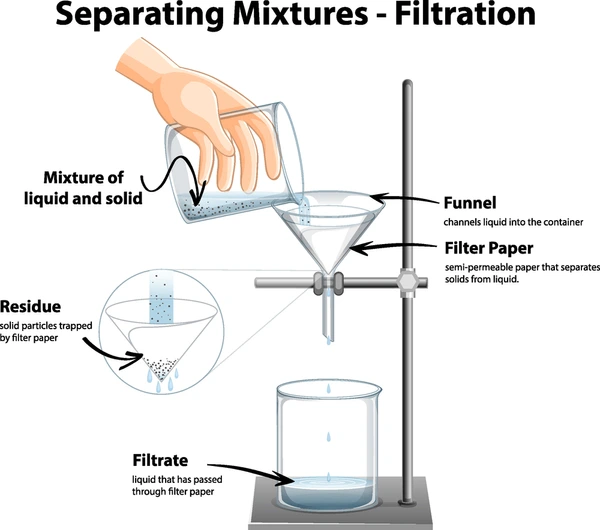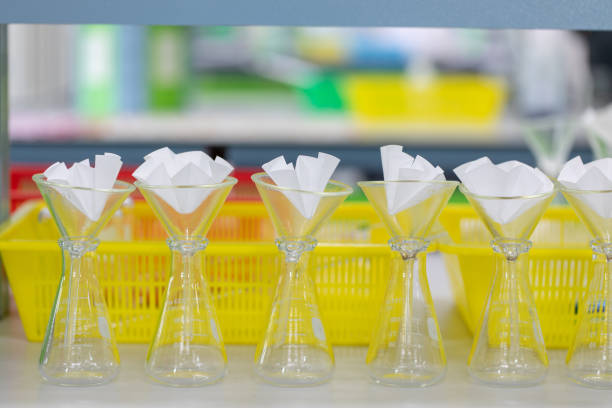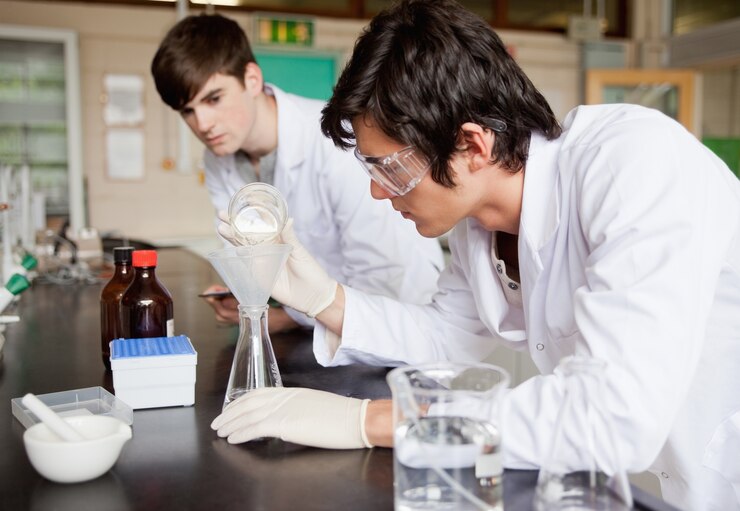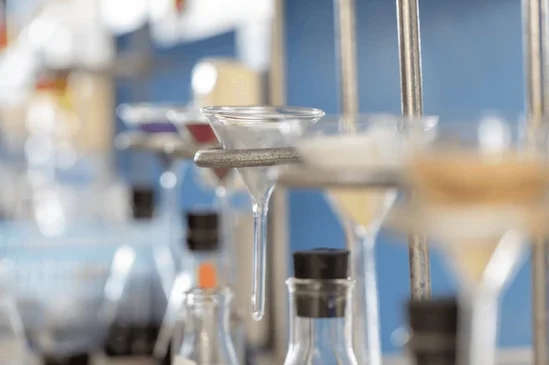Filtration is a fundamental chemical separation technique widely used to separate insoluble solids from liquids. The Filtration Lab Experiment will provide a comprehensive guide to designing a filtration process, suitable for IGCSE Chemistry students. We will explore the principles, materials required, step-by-step procedures, observations, and common errors to avoid.
Aim of the Filtration Lab Experiment
This experiment demonstrates how filtration works by separating an insoluble solid from a liquid using filter paper and a funnel.
Hypothesis
If a mixture of an insoluble solid and a liquid is passed through filter paper, the solid (residue) will remain on the paper, while the liquid (filtrate) will pass through.
Materials Required
To conduct the Filtration Lab experiment efficiently, the following materials are required:

- Beaker (250 mL) – To hold the mixture.
- Filter paper – Acts as the medium for filtration.
- Funnel – Supports the filter paper and directs the filtrate.
- Glass rod – Assists in pouring the mixture smoothly.
- Stirring rod – Helps in proper mixing before filtration.
- A mixture of sand and water – The sample is to be filtered.
- Retort stand with clamp – Holds the funnel in place.
- Conical flask – Collects the filtrate.
- Distilled water – For washing residue, if necessary.
Methodology: Step-by-Step Procedure
Step 1: Preparing the Filtration Lab Setup
- Create a cone shape with the filter paper by first folding it in half and then folding it again into quarters.
- Place the folded filter paper inside the funnel and moisten it slightly with distilled water to ensure it adheres to the funnel walls.
- Set up the apparatus by placing the funnel inside the neck of a conical flask. Secure the funnel with a retort stand and clamp if necessary.
Step 2: Preparing the Mixture
- Take a beaker and add about 100 mL of water.
- Add a spoonful of sand into the water and stir it thoroughly using a stirring rod to form an even mixture.
Step 3: Performing the Filtration

- Gently pour the mixture through the funnel into the filter paper using a glass rod to guide the liquid and prevent splashing.
- Let the mixture pass through the filter paper. The liquid, known as the filtrate, will collect in the conical flask, while the solid material, or residue, will remain on the filter paper.
- Observe the separation process.
Observations
- The sand remains on the filter paper as residue.
- The water that passes through appears clear and is called the filtrate.
- Over time, the sand accumulates on the filter paper, and filtration slows down.
Discussion and Explanation of Filtration Lab
Filtration is based on particle size difference. The filter paper has tiny pores that allow only liquid molecules to pass through while trapping larger solid particles. This process effectively separates insoluble substances from a liquid medium.
Why Does Filtration Work?

- Filter paper acts as a semi-permeable barrier that retains larger particles.
- Gravity aids in the movement of liquid through the funnel.
- The residue stays on the filter paper because its particle size is larger than the filter pores.
- The filtrate is clear, demonstrating successful separation.
Applications of Filtration in Daily Life
Filtration is widely used in:
- Water purification – Removing solid impurities from drinking water.
- Coffee brewing – Separating coffee grounds from liquid coffee.
- Air filtration – Removing dust and pollutants from air conditioners.
- Pharmaceutical industries – Purifying chemicals and medicines.
Common Errors and Precautions
To ensure a successful filtration lab experiment, avoid these mistakes:
- Incorrect filter paper folding – Always fold into a cone shape for better stability.
- Overloading the filter paper – Pour the mixture gradually to prevent overflow.
- Tearing the filter paper – Moisten it before use to make it stick properly.
- Not supporting the funnel properly – Always secure the funnel to prevent tipping over.
Filtration techniques are vital tools in both scientific research and industrial processes. Choosing the right filtration method depends on the nature of the mixture, the desired speed, and the precision required. By understanding these techniques, we can ensure efficient separation, enhanced purity, and better outcomes in various applications.
Conclusion
The filtration lab experiment effectively illustrates how filtration distinguishes insoluble solids from liquids. The filter paper serves as a physical barrier, permitting the liquid to flow through while trapping the solid. Grasping this process is essential in chemistry and has many practical applications in the real world.
What are the steps of a filtration lab?
Aim of the Filtration Lab Experiment
This experiment demonstrates how filtration works by separating an insoluble solid from a liquid using filter paper and a funnel.
Hypothesis
If a mixture of an insoluble solid and a liquid is passed through filter paper, the solid (residue) will remain on the paper, while the liquid (filtrate) will pass through.
Materials Required
To conduct the Filtration Lab experiment efficiently, the following materials are required:

Beaker (250 mL) – To hold the mixture.
Filter paper – Acts as the medium for filtration.
Funnel – Supports the filter paper and directs the filtrate.
Glass rod – Assists in pouring the mixture smoothly.
Stirring rod – Helps in proper mixing before filtration.
A mixture of sand and water – The sample is to be filtered.
Retort stand with clamp – Holds the funnel in place.
Conical flask – Collects the filtrate.
Distilled water – For washing residue if necessary.
Methodology: step-by-step Procedure
Step 1: Preparing the Filtration Lab Setup
Create a cone shape with the filter paper by first folding it in half, and then folding it again into quarters.
Place the folded filter paper inside the funnel and moisten it slightly with distilled water to ensure it adheres to the funnel walls.
Set up the apparatus by placing the funnel inside the neck of a conical flask. Secure the funnel with a retort stand and clamp if necessary.
Step 2: Preparing the Mixture
Take a beaker and add about 100 mL of water.
Add a spoonful of sand into the water and stir it thoroughly using a stirring rod to form an even mixture.
Step 3: Performing the Filtration

Gently pour the mixture through the funnel into the filter paper using a glass rod to guide the liquid and prevent splashing.
Let the mixture pass through the filter paper. The liquid, known as the filtrate, will collect in the conical flask, while the solid material, or residue, will remain on the filter paper.
Observe the separation process.
Observations
The sand remains on the filter paper as residue.
The water that passes through appears clear and is called the filtrate.
Over time, the sand accumulates on the filter paper, and filtration slows down.
Discussion and Explanation of Filtration Lab
Filtration is based on particle size difference. The filter paper has tiny pores that allow only liquid molecules to pass through while trapping larger solid particles. This process effectively separates insoluble substances from a liquid medium.
Why Does Filtration Work?

Filter paper acts as a semi-permeable barrier that retains larger particles.
Gravity aids in the movement of liquid through the funnel.
The residue stays on the filter paper because its particle size is larger than the filter pores.
The filtrate is clear, demonstrating successful separation.
Applications of Filtration in Daily Life
Filtration is widely used in:
Water purification – Removing solid impurities from drinking water.
Coffee brewing – Separating coffee grounds from liquid coffee.
Air filtration – Removing dust and pollutants in air conditioners.
Pharmaceutical industries – Purifying chemicals and medicines.
Common Errors and Precautions
To ensure a successful filtration lab experiment, avoid these mistakes:
Incorrect filter paper folding – Always fold into a cone shape for better stability.
Overloading the filter paper – Pour the mixture gradually to prevent overflow.
Tearing the filter paper – Moisten it before use to make it stick properly.
Not supporting the funnel properly – Always secure the funnel to prevent tipping over.
Filtration techniques are vital tools in both scientific research and industrial processes. Choosing the right filtration method depends on the nature of the mixture, the desired speed, and the precision required. By understanding these techniques, we can ensure efficient separation, enhanced purity, and better outcomes in various applications.
Conclusion
The filtration lab experiment effectively illustrates how filtration distinguishes insoluble solids from liquids. The filter paper serves as a physical barrier, permitting the liquid to flow through while trapping the solid. Grasping this process is essential in chemistry and has many practical applications in the real world.
What is the filtration?
Aim of the Filtration Lab Experiment
This experiment demonstrates how filtration works by separating an insoluble solid from a liquid using filter paper and a funnel.
Hypothesis
If a mixture of an insoluble solid and a liquid is passed through filter paper, the solid (residue) will remain on the paper, while the liquid (filtrate) will pass through.
Materials Required
To conduct the Filtration Lab experiment efficiently, the following materials are required:

Beaker (250 mL) – To hold the mixture.
Filter paper – Acts as the medium for filtration.
Funnel – Supports the filter paper and directs the filtrate.
Glass rod – Assists in pouring the mixture smoothly.
Stirring rod – Helps in proper mixing before filtration.
A mixture of sand and water – The sample is to be filtered.
Retort stand with clamp – Holds the funnel in place.
Conical flask – Collects the filtrate.
Distilled water – For washing residue if necessary.
Methodology: step-by-step Procedure
Step 1: Preparing the Filtration Lab Setup
Create a cone shape with the filter paper by first folding it in half, and then folding it again into quarters.
Place the folded filter paper inside the funnel and moisten it slightly with distilled water to ensure it adheres to the funnel walls.
Set up the apparatus by placing the funnel inside the neck of a conical flask. Secure the funnel with a retort stand and clamp if necessary.
Step 2: Preparing the Mixture
Take a beaker and add about 100 mL of water.
Add a spoonful of sand into the water and stir it thoroughly using a stirring rod to form an even mixture.
Step 3: Performing the Filtration

Gently pour the mixture through the funnel into the filter paper using a glass rod to guide the liquid and prevent splashing.
Let the mixture pass through the filter paper. The liquid, known as the filtrate, will collect in the conical flask, while the solid material, or residue, will remain on the filter paper.
Observe the separation process.
Observations
The sand remains on the filter paper as residue.
The water that passes through appears clear and is called the filtrate.
Over time, the sand accumulates on the filter paper, and filtration slows down.
Discussion and Explanation of Filtration Lab
Filtration is based on particle size difference. The filter paper has tiny pores that allow only liquid molecules to pass through while trapping larger solid particles. This process effectively separates insoluble substances from a liquid medium.
Why Does Filtration Work?

Filter paper acts as a semi-permeable barrier that retains larger particles.
Gravity aids in the movement of liquid through the funnel.
The residue stays on the filter paper because its particle size is larger than the filter pores.
The filtrate is clear, demonstrating successful separation.
Applications of Filtration in Daily Life
Filtration is widely used in:
Water purification – Removing solid impurities from drinking water.
Coffee brewing – Separating coffee grounds from liquid coffee.
Air filtration – Removing dust and pollutants in air conditioners.
Pharmaceutical industries – Purifying chemicals and medicines.
Common Errors and Precautions
To ensure a successful filtration lab experiment, avoid these mistakes:
Incorrect filter paper folding – Always fold into a cone shape for better stability.
Overloading the filter paper – Pour the mixture gradually to prevent overflow.
Tearing the filter paper – Moisten it before use to make it stick properly.
Not supporting the funnel properly – Always secure the funnel to prevent tipping over.
Filtration techniques are vital tools in both scientific research and industrial processes. Choosing the right filtration method depends on the nature of the mixture, the desired speed, and the precision required. By understanding these techniques, we can ensure efficient separation, enhanced purity, and better outcomes in various applications.
Conclusion
The filtration lab experiment effectively illustrates how filtration distinguishes insoluble solids from liquids. The filter paper serves as a physical barrier, permitting the liquid to flow through while trapping the solid. Grasping this process is essential in chemistry and has many practical applications in the real world.
What are the stages of the filtration lab?
Step 1: Preparing the Filtration Lab Setup
Create a cone shape with the filter paper by first folding it in half, and then folding it again into quarters.
Place the folded filter paper inside the funnel and moisten it slightly with distilled water to ensure it adheres to the funnel walls.
Set up the apparatus by placing the funnel inside the neck of a conical flask. Secure the funnel with a retort stand and clamp if necessary.
Step 2: Preparing the Mixture
Take a beaker and add about 100 mL of water.
Add a spoonful of sand into the water and stir it thoroughly using a stirring rod to form an even mixture.
Step 3: Performing the Filtration

Gently pour the mixture through the funnel into the filter paper using a glass rod to guide the liquid and prevent splashing.
Let the mixture pass through the filter paper. The liquid, known as the filtrate, will collect in the conical flask, while the solid material, or residue, will remain on the filter paper.
Observe the separation process.
Observations
The sand remains on the filter paper as residue.
The water that passes through appears clear and is called the filtrate.
Over time, the sand accumulates on the filter paper, and filtration slows down.
Discussion and Explanation of Filtration Lab
Filtration is based on particle size difference. The filter paper has tiny pores that allow only liquid molecules to pass through while trapping larger solid particles. This process effectively separates insoluble substances from a liquid medium.
Why Does Filtration Work?

Filter paper acts as a semi-permeable barrier that retains larger particles.
Gravity aids in the movement of liquid through the funnel.
The residue stays on the filter paper because its particle size is larger than the filter pores.
The filtrate is clear, demonstrating successful separation.
What is the principle of the Filtration?
Aim of the Filtration Lab Experiment
This experiment demonstrates how filtration works by separating an insoluble solid from a liquid using filter paper and a funnel.
Hypothesis
If a mixture of an insoluble solid and a liquid is passed through filter paper, the solid (residue) will remain on the paper, while the liquid (filtrate) will pass through.
Materials Required
To conduct the Filtration Lab experiment efficiently, the following materials are required:

Beaker (250 mL) – To hold the mixture.
Filter paper – Acts as the medium for filtration.
Funnel – Supports the filter paper and directs the filtrate.
Glass rod – Assists in pouring the mixture smoothly.
Stirring rod – Helps in proper mixing before filtration.
A mixture of sand and water – The sample is to be filtered.
Retort stand with clamp – Holds the funnel in place.
Conical flask – Collects the filtrate.
Distilled water – For washing residue if necessary.
Methodology: step-by-step Procedure
Step 1: Preparing the Filtration Lab Setup
Create a cone shape with the filter paper by first folding it in half, and then folding it again into quarters.
Place the folded filter paper inside the funnel and moisten it slightly with distilled water to ensure it adheres to the funnel walls.
Set up the apparatus by placing the funnel inside the neck of a conical flask. Secure the funnel with a retort stand and clamp if necessary.
Step 2: Preparing the Mixture
Take a beaker and add about 100 mL of water.
Add a spoonful of sand into the water and stir it thoroughly using a stirring rod to form an even mixture.
Step 3: Performing the Filtration

Gently pour the mixture through the funnel into the filter paper using a glass rod to guide the liquid and prevent splashing.
Let the mixture pass through the filter paper. The liquid, known as the filtrate, will collect in the conical flask, while the solid material, or residue, will remain on the filter paper.
Observe the separation process.
Observations
The sand remains on the filter paper as residue.
The water that passes through appears clear and is called the filtrate.
Over time, the sand accumulates on the filter paper, and filtration slows down.
Discussion and Explanation of Filtration Lab
Filtration is based on particle size difference. The filter paper has tiny pores that allow only liquid molecules to pass through while trapping larger solid particles. This process effectively separates insoluble substances from a liquid medium.
Why Does Filtration Work?

Filter paper acts as a semi-permeable barrier that retains larger particles.
Gravity aids in the movement of liquid through the funnel.
The residue stays on the filter paper because its particle size is larger than the filter pores.
The filtrate is clear, demonstrating successful separation.
Applications of Filtration in Daily Life
Filtration is widely used in:
Water purification – Removing solid impurities from drinking water.
Coffee brewing – Separating coffee grounds from liquid coffee.
Air filtration – Removing dust and pollutants in air conditioners.
Pharmaceutical industries – Purifying chemicals and medicines.
Common Errors and Precautions
To ensure a successful filtration lab experiment, avoid these mistakes:
Incorrect filter paper folding – Always fold into a cone shape for better stability.
Overloading the filter paper – Pour the mixture gradually to prevent overflow.
Tearing the filter paper – Moisten it before use to make it stick properly.
Not supporting the funnel properly – Always secure the funnel to prevent tipping over.
Filtration techniques are vital tools in both scientific research and industrial processes. Choosing the right filtration method depends on the nature of the mixture, the desired speed, and the precision required. By understanding these techniques, we can ensure efficient separation, enhanced purity, and better outcomes in various applications.
Conclusion
The filtration lab experiment effectively illustrates how filtration distinguishes insoluble solids from liquids. The filter paper serves as a physical barrier, permitting the liquid to flow through while trapping the solid. Grasping this process is essential in chemistry and has many practical applications in the real world.
What are the materials required for the filtration?
To conduct the Filtration Lab experiment efficiently, the following materials are required:

Beaker (250 mL) – To hold the mixture.
Filter paper – Acts as the medium for filtration.
Funnel – Supports the filter paper and directs the filtrate.
Glass rod – Assists in pouring the mixture smoothly.
Stirring rod – Helps in proper mixing before filtration.
A mixture of sand and water – The sample is to be filtered.
Retort stand with clamp – Holds the funnel in place.
Conical flask – Collects the filtrate.
Distilled water – For washing residue if necessary.

1 thought on “Filtration Lab Experiment”